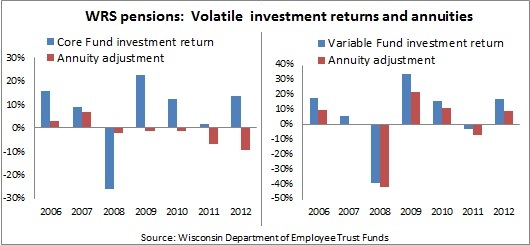When the Wisconsin Retirement System released its annual annuity adjustment for pensioners earlier this month, members groaned while taxpayers breathed a sigh of relief.
The WRS is the ninth largest pension fund in the country. It is also among the country’s best funded plans in terms of long-term assets and liabilities; since 2004, its funding ratio has been near 100 percent. Yet starting May 1, certain WRS retirees will see their monthly checks fall by almost 10 percent—unheard of among the millions of public sector pensioners. In fact, it’s the fourth consecutive year of annuity cuts for some retirees. There are several sources behind this seeming financial contradiction. But the most important is that WRS retirees assume the large majority of investment return risk.
Along with worker and employer contributions, pension funds depend heavily on investment returns on their assets. Pension plans assume a certain rate of return—7.2 percent for the WRS, while many others hover around 8 percent—to project member annuities upon retirement. Most pension plans also average returns over five years to “smooth” volatility. But two of the past five years’ returns have fallen well short of the WRS benchmark, including 2008, when two WRS pension funds lost roughly 30 percent of their combined value (see charts).

When investment returns fall short of this benchmark, all other things equal, unfunded liabilities accrue. For most plans, this gap typically requires additional contributions from government employers (via taxpayers) and often existing workers; by and large, retirees are financially exempt.
In sharp contrast, WRS retirees bear the majority of investment risk and therefore reap both more benefits and more hardship. Unlike many public pension plans, the WRS plan offers no automatic cost-of-living adjustment. Instead, it uses investment returns to pad monthly pension checks on a compound basis. Such a policy worked well for retirees during the 1990s, when heady investment returns led to annual pension adjustments (called dividends) averaging almost 7 percent.
But when investment returns go south—which they did during the 2001 and (especially) 2008 recessions—those dividends can be clawed back to ensure the plan’s long-term financial solvency. But a retiree’s annuity can never go lower than the original amount established at retirement. The investment drop in 2008 was so severe—and compounded by a weak 2011—that the WRS has been forced to take back dividends from its Core Fund (which funds roughly 90 percent of annuities) for four consecutive years. (The smaller Variable Fund has no such annuity floor, and investment gains and losses are fully recognized each year.)
The amount of annuity decrease for a retiree depends on the dividends previously earned. Given three previous years of negative adjustments, the Wisconsin Department of Employee Trust Funds anticipates that close to half of all WRS retirees will see no downward adjustment this year because they have no dividends left to take and are back at their original retirement annuity. This year’s clawback also was larger on a percentage basis because of the shrinking pool of retirees with dividends remaining. After this year’s adjustments, virtually anyone who has been retired since 2000 will be back to his or her original annuity level, according to WRS's latest actuarial report.
The good news for retirees is that this is the last year that 2008 returns will be averaged into investment returns for the Core Fund. Barring another market downturn, retirees should see a little more on their monthly checks next year.
Ron Wirtz is a Minneapolis Fed regional outreach director. Ron tracks current business conditions, with a focus on employment and wages, construction, real estate, consumer spending, and tourism. In this role, he networks with businesses in the Bank’s six-state region and gives frequent speeches on economic conditions. Follow him on Twitter @RonWirtz.





